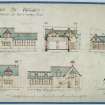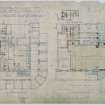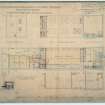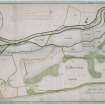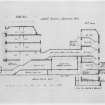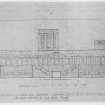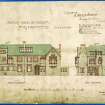Records of Cowie and Seaton, architects, Edinburgh, Scotland
551 40
Description Records of Cowie and Seaton, architects, Edinburgh, Scotland
Date 1880 to 1990
Collection Records of Cowie and Seaton, architects, Edinburgh, Scotland
Catalogue Number 551 40
Category All Other
Scope and Content There are over 10,300 papers in the Cowie & Seaton Collection, of which 5,800 were catalogued as a part of SAPPP. The bulk of the drawings are from the 1920s onwards and consequently there are many projects from the first three decades of the practice that are not included in the Collection. Approximately 10% of the Collection comprises drawings of various buildings for Edinburgh Academy, Henderson Row, including the library (1899, altered 1930) and a war memorial building with gymnasium and workshops (1922-23). A particular feature of the Cowie and Seaton Collection is the large number of acquired drawings of national significance from other architectural practices, such as Robert S Lorimer; Alexander Nisbet Patterson; Rowand Anderson & Paul; and Gillespie Kidd & Coia. Also reflected in the Collection are alterations by Morton J H Cowie to a number of buildings that had previously been worked on by the Dick Peddie & McKay practice in its various guises. The bulk of the Collection is on copy and tracing paper, with the use of linseed paper in projects prior to 1920. There are many sketches and drawings made on the reverse of material such as diary pages, letters etc. A number of the drawings in the 1930s were on the reverse of acquired promotional material such as letters of introduction from businesses and calendars from Issac Braithwaite.
Archive History The Collection was gifted to the Royal Incorporation of Architects in Scotland (RIAS) by Douglas William Seaton on his retirement in 1993 and was handlisted a year later by RIAS volunteers. At this stage the Collection comprised material from the practices of Leadbetter & Fairley; Leadbetter Fairley & Reid; Morton J H Cowie; Cowie & D Gardiner Hardie; and Cowie & Seaton. All papers dating before 1960 in the Collection had evidently been stored flat, and there is evidence to suggest that reorganisation of the Collection had perhaps taken place around the time of Morton J H Cowie’s retirement. Later papers from the Cowie & Seaton partnership were rolled and wrapped in bitumen paper. The Collection was catalogued and conserved as part of the Scottish Architects' Papers Preservation Project (SAPPP) between 1999 and 2004. All projects by Leadbetter Fairley & Reid, as well as all projects begun by them, in the mid-1940s and finished by the new firm of Morton J H Cowie were catalogued as part of SAPPP. Eight Morton J H Cowie projects with acquired drawings of historic interest were also catalogued. The remainder of the Collection has been handlisted. Approximately 70 drawings in the collection received conservation treatment through SAPPP. About 180 more still require repairs before they can be made accessible to the public.
System of Arrangement All items for each building are grouped together into projects. Projects are then grouped by decade, with all projects numbered by the earliest decade in which they appeared. All un-catalogued material is hand listed and held at Baileyfield storage facility.
Related Material The SAPPP Dick Peddie & McKay Collection holds material relating to the Cowie & Seaton Collection. For other Leadbetter Fairley & Reid papers, see the SAPPP Ian G Lindsay and Sinclair Macdonald & Son Collections. The RIAS series of architectural guides mention a number of buildings by Leadbetter, Fairley and Reid in their various guises, most of which are not included in the Collection. The Edinburgh volume from the Buildings of Scotland series by John Gifford, Colin McWilliam and David Walker (revised 1991) also has entries for several buildings worked on by the firm. The unpublished research of Gillean Petrie Small, a retired partner of the Glasgow-based Monro and Partners practice and RIAS volunteer, has also been used to compile this collection essay. RIBA nomination papers are held in the RIBA Archive at the Victoria & Albert Museum, London.
Access Conditions Access is unrestricted, except where conservation concerns exist.
Administrative History The practice was established in 1884 by Thomas Greenshields Leadbetter (1859-1931) at 122 George Street, Edinburgh. This building was owned by John Dick Peddie (1824-1891) and also occupied by Sydney Mitchell (1856-1930) around the same date. Leadbetter’s family were Lanarkshire and Roxburghshire landed gentry, and country house commissions for friends and relations formed a large proportion of his work. James McLellan Fairley (1860-1942) was apprenticed to Hippolyte Jean Blanc (1844-1917) in 1875 and over the next five years he spent time in the offices of Wardrop & Reid, Archibald Macpherson, Walter Wood Robertson of the Office of Works and Sydney Mitchell. Fairley passed the RIBA qualifying exam in 1886 and became an associate on 21 June of that year, his proposers being Arthur Cates (1829-1901), George Washington Browne (1853-1939), John Kinross (1855-1931) and Leadbetter. It would appear that Fairley had begun practice on his own account by 1886, although the inclusion of Leadbetter’s name on his nomination form suggests he may have been assisting with Leadbettter’s practice. In 1885 Fairley went into partnership with Leadbetter at 17 Young Street, Edinburgh. Buildings from this partnership include the Carnegie Library, Wick (1895-98) and a library at Edinburgh Academy (1899), the Academy remaining a client of the practice for many years to come. Leadbetter remained an active partner in the practice until about 1909, after which he retained responsibility only for projects in which he had a particular interest. At this point, Fairley took Robert Stirling Reid (1883-1947) into partnership. Reid had previously been apprenticed to Leadbetter & Fairley (1901-1905) and also spent some years with Dick Peddie & Washington Browne, and Dick Peddie & Forbes Smith. Leadbetter Fairley & Reid carried out a large amount of improvement work to houses in Edinburgh and the surrounding area including many properties in Edinburgh’s New Town. Country house work includes an extension and improvements to Auchendinny House, Midlothian (1914-30) and the restoration of the late 18th century Chesters House in Roxburghshire (1934-40). Following the Great War the practice was engaged in improvement work on several commercial and leisure-related buildings, including a conversion of 24 Charlotte Square and the adjoining 13-15 Hope Street into bank premises (1922-1923); a considerable amount of work for J & G Cox’s Glue Works at Gorgie Mills, Edinburgh, for whom they worked between 1926 and 1960; alterations to Edinburgh hospitals and related buildings; and the design of several new houses in and out of Edinburgh in the 1920s and 1930s. At some point during the 1930s Morton John Heddell Cowie (1905-1972) joined the practice. Cowie, a student member of the RIAS (1930-1932), qualified as an architect in 1933 and carried out a small amount of business from his parents’ home at ‘Durrisdeere’, 30 St John’s Road, Edinburgh. Between 1935 and 1940 he was involved in a part-time partnership with David Gardiner Hardie based in a boarding house at 11 Melville Street, Leith. Cowie & Hardie were involved in the design and construction of air raid shelters across Edinburgh from 1939, and in the following year Hardie patented his own shelter design. In 1946 Reid retired from Leadbetter Fairley & Reid, dying shortly afterwards. Cowie, who had returned to the practice after service in the war, moved the business during the summer of 1948 to 53 Manor Place, Edinburgh. These premises had been altered by Leadbetter Fairley & Reid to form offices in 1947. The practice was renamed Morton J H Cowie and continued work for existing clients such as Edinburgh Academy and J & G Cox, as well as attracting new customers such as the National Coal Board. In 1961 Cowie took Douglas William Seaton into partnership, forming Morton J H Cowie & Seaton. Cowie retired in 1970 and Seaton continued the practice under the same name until his own retirement from offices in Castle Terrace.
Accruals No further accruals are expected.
Accession Number 1992/52
Permalink http://canmore.org.uk/collection/1176339




